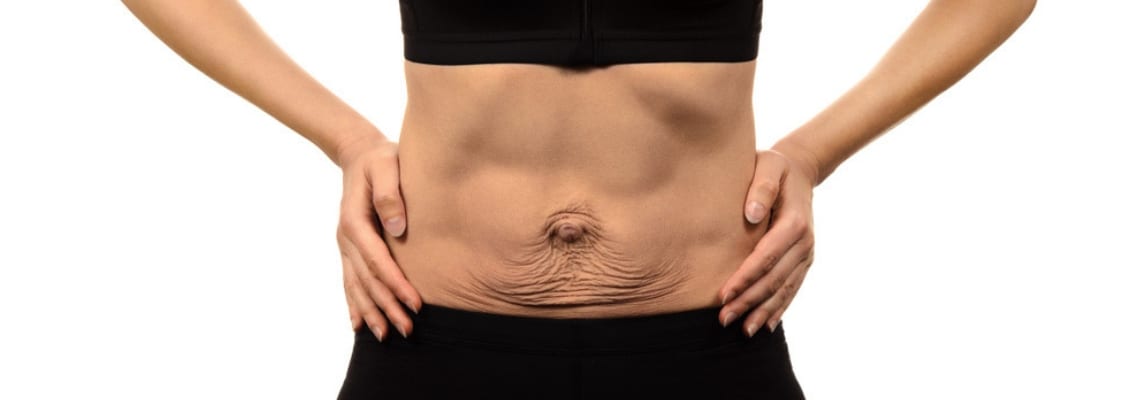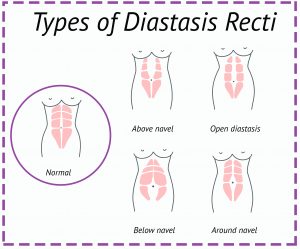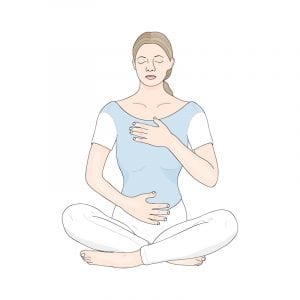
Once you have gone through childbirth and postpartum recovery, it can be very exciting to be cleared to exercise again. While you may want to jump right back into your old exercise routine, it is important to remember all of the hard work and healing your body has just gone through.
Many women experience something called Diastasis Recti due to pregnancy. If you have noticed that you are shedding your pregnancy weight everywhere but your stomach, you may be suffering from Diastasis Recti.
We have put together a guide to help to identify Diastasis Recti and to help treat and recover from it.
What is Diastasis Recti?
Diastasis Recti is a normal thing to occur after pregnancy, as for some women the muscles do not shrink back down on their own. It affects about two-thirds of pregnant women. “Diastasis Recti” means that your stomach sticks out because the space between your left and right ab muscles has widened. The word “Diastasis” means separation and the word “Recti” refers to the ab muscles called “rectus abdominis.”
Due to hormones during pregnancy, your muscles loosen up to help with your growing belly and to help to accommodate your stretching skin and bone separation. Pregnancy can cause your six-pack muscles to separate in two halves.
If you notice that your stomach has not flattened out by eight weeks postpartum, then you may also be at risk for other possible health issues. You may even experience pelvic pain, pelvic organ prolapse, and painful sex.
How it Occurs
Your growing uterus during pregnancy stretches the muscles in the abdomen. This can cause the parallel strip of muscles that create a six- pack in the middle of our abdominal muscles to become separated by an abnormal distance.
If you have carried multiples or have brought a large baby to term then you may be more likely to develop Diastasis Recti. The same applies if you have a small fit and stature or are 35 years or older.
How to Identify Diastasis Recti
 Diastasis recti may cause obvious physical conditions such as a bulge in the middle of the abdomen where the muscles have separated, or a noticeable separation may be felt when the abdominal muscles are tense or tightened. In addition, diastasis recti may present itself with additional symptoms such as lower back pain, bloating, poor posture or constipation. The pelvic floor related issue such as incontinence may also be a symptom, as this leakage or weakness of the bladder, while normal during pregnancy, is not a normal, long-term postpartum issue. While these symptoms may be noticeable, in some cases, diastasis recti may not present itself or may go unnoticed.
Diastasis recti may cause obvious physical conditions such as a bulge in the middle of the abdomen where the muscles have separated, or a noticeable separation may be felt when the abdominal muscles are tense or tightened. In addition, diastasis recti may present itself with additional symptoms such as lower back pain, bloating, poor posture or constipation. The pelvic floor related issue such as incontinence may also be a symptom, as this leakage or weakness of the bladder, while normal during pregnancy, is not a normal, long-term postpartum issue. While these symptoms may be noticeable, in some cases, diastasis recti may not present itself or may go unnoticed.
It is also important to note that even though a new mom may have a flat stomach after birth, ab separation is still a possible present condition. The same assumption goes for women with a larger belly postpartum, in the sense that a larger abdomen does not necessarily mean that they are suffering from diastasis recti. The main concern with diastasis recti should be focused on function and not appearance.
Regardless of symptoms or stomach size postpartum, there are ways to check for abdominal muscle separation. To properly check if this condition is present, or to check on the recovery progress of diastasis recti, follow the following routine.
- Begin by laying on your back in a comfortable position and bend your knees toward the sky while placing your feet flat on the floor.
- Place one hand on the midline of your core with your fingers placed flat on the midline area above the belly button, and place your other hand under your head and neck for support.
- Slowly lift your head and begin adding light pressure through the pads of your fingers on your midline.
With no diastasis recti, there is the sensation of a toned abdominal wall as you lift your head, however, if you feel a space, or your fingers sink into your core, you likely have diastasis recti, especially if you feel more than one fingers width of separation.
Repeat this process for the areas directly above your belly button down to the pubis to determine whether the diastasis recti is isolated or in the core as a whole.
Tips on How to Treat and Recover
If you are suffering from Diastasis Recti, rehab is the best way to work towards recovery. Rehab is focusing on restacking the rib cage over the pelvis. Rehab is largely made up from breathing exercises and practicing proper posture. These are all designed to help stretch out and strengthen the core muscles.
- Do not strain yourself. If you strain your body while recovering, it is possible to make things worse. Straining while lifting heavy things, which could include your children, and during constipation will also strain your abdominal tissue. It is even possible that standing up and sitting down could strain your muscles depending on how large the split is. This is because you are lifting your own body weight in both cases. Make sure to take it easy and rest when your body feels as if it needs it.
- Be careful when it comes to exercise. It is important to not overdo it and push your body before it is ready during rehab. Some fitness routines such as crunches, pushups, press-ups, and front planks can make abdominal separation worse. Exercises such as swimming and certain yoga poses can also be harmful when healing from Diastasis Recti.
- Focus on healing the belly. Research shows the Tupler technique is a great way to help bring the belly muscles into line. This technique involves exercises that are done while wearing a belly splint that helps to protect and hold the ab muscles together.
 Try diaphragmatic breathing. Taking a deep breathe, fill your belly up completely but try to avoid letting your ribs move up as you inhale. Think of your belly and rib cage opening up like an umbrella. Once you exhale, close the umbrella and draw your belly towards the spine. Repeat this breathe pattern at least ten times.
Try diaphragmatic breathing. Taking a deep breathe, fill your belly up completely but try to avoid letting your ribs move up as you inhale. Think of your belly and rib cage opening up like an umbrella. Once you exhale, close the umbrella and draw your belly towards the spine. Repeat this breathe pattern at least ten times.- Hip raises. Lay on your back with your knees bent up. Try to ground your shoulders into the floor and press your weight into your heels. Upon exhale, squeeze your glutes as you press your hips up into the air. Hold for a moment, then slowly lower down.
- Cat -Cow. Start on your hands and knees, have your hands lined up under your shoulders and knees under your hips. Once you inhale, fill your belly and drop it towards the floor (allowing your back to arch). Exhale to press the air out and draw your belly up and in (pushing your spine up toward the ceiling). At the same time allow your head to fall towards your chest. Repeat this motion slowly.
- Spinal balance. Get onto your hands and knees, make sure that your knees are stacked under your hips and your hands are stacked in line with your shoulders. Keep the lower portion of your abs pulled in and breathe. At the beginning, do lift one leg and one arm at a time. Once you get used to one arm or leg at a time, you can try to lift the opposite hand and leg at once. Finally, try to add small pulses at the top.
- Marches and toe drops. Lay on your back with your feet flat on the floor and your legs bent. Exhale as you lift one leg off of the floor and then lower it back down with control before switching to the opposite leg. Try to keep everything else stable, keep your abs pulled in throughout the exercise. If you feel anything pushing out or strange during this exercise, make sure to relax and not push things. Once you feel good at marching, try adding in toe drops. Begin in a table top position on your back. Have your legs bent and feet lifted off of the floor. Gently lower one toe towards the floor at a time. Keep repeating slowly. Make sure to keep breathing throughout the exercise.
Other Ways of Treatment
If rehab doesn’t work for you, then surgery may be an option. An operation that can help to correct diastasis may be called a “tummy tuck” or “abdominoplasty.” This is where a surgeon will fold and sew the weak central ridge together.
It also may be possible to get a laparoscopy, this is a surgery done with small cuts instead of one large one. It is important to keep in mind that surgery may have possible side effects such as scarring or infection.
Take the time to talk to your health care provider. You may even want to seek help from a physical therapist to help determine the exercises that are right for you.


